INDIAN ARMED FORCES CHIEFS ON OUR RELENTLESS AND FOCUSED PUBLISHING EFFORTS

The insightful articles, inspiring narrations and analytical perspectives presented by the Editorial Team, establish an alluring connect with the reader. My compliments and best wishes to SP Guide Publications.

"Over the past 60 years, the growth of SP Guide Publications has mirrored the rising stature of Indian Navy. Its well-researched and informative magazines on Defence and Aerospace sector have served to shape an educated opinion of our military personnel, policy makers and the public alike. I wish SP's Publication team continued success, fair winds and following seas in all future endeavour!"

Since, its inception in 1964, SP Guide Publications has consistently demonstrated commitment to high-quality journalism in the aerospace and defence sectors, earning a well-deserved reputation as Asia's largest media house in this domain. I wish SP Guide Publications continued success in its pursuit of excellence.
- MoD initiates comprehensive review of Defence Acquisition Procedure 2020, pushes for defence reforms
- G7: The Swansong
- Kalinga Connect: South Asia to Polynesia
- Advanced MRSAM for India for a greater firepower
- Must Credit DRDO for Operation Sindoor, now what is next for defence R&D?
- Operation Sindoor | Day 2 DGMOs Briefing
- Operation Sindoor: Resolute yet Restrained
Commissioning of INS 'Vikrant'
The successful delivery of the indigenous carrier is testimony to the dedicated efforts of a large number of stakeholders within the Indian Navy, shipyard, industry, Original Equipment Manufacturers (OEM) and MSMEs for over two decades
 |
The Author is Former Director General of Information Systems and A Special Forces Veteran, Indian Army |
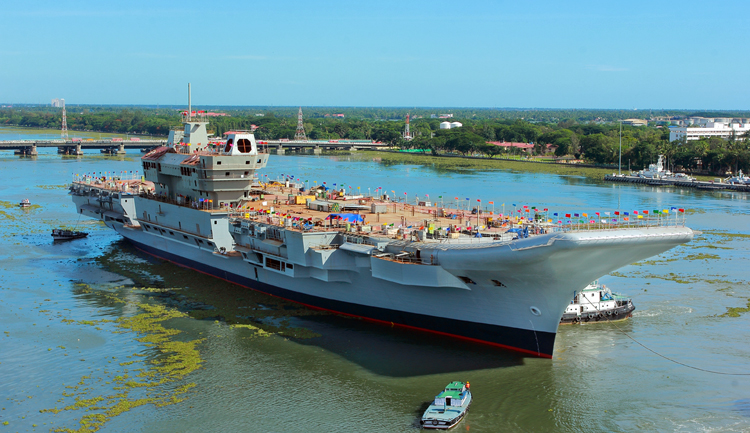
According to sources, Prime Minister Narendra Modi will commission the aircraft carrier IAC-1 (INS ‘Vikrant’) at Cochin on September 1, 2022. This then will be a proud day for India and the defence establishment especially for the Indian Navy. This will bolster India’s capability in the Indian Ocean Region (IOR) and the Navy’s quest for a Blue Water Navy. Earlier on July 28, 2022, the Navy took delivery of IAC-1 (Vikrant) from the builder Cochin Shipyard Limited (CSL), Kochi. This also was a historical landmark. The warship is designed by the Indian Navy’s in-house Directorate of Naval Design (DND) and built by CSL, a Public Sector Shipyard under the Ministry of Shipping (MoS).
In 1999, Defence Minister George Fernandes authorised the development and construction of an aircraft carrier, 'INS Vikrant', under the Project 71 Air Defence Ship (ADS). In August 2006, the then Chief of Naval Staff, Admiral Arun Prakash stated that the designation for the vessel had been changed from Air Defence Ship (ADS) to Indigenous Aircraft Carrier (IAC). Final revisions to the design increased the displacement of the carrier from 37,500 tonnes to 45,000 tonnes. The length of the ship also increased from 252 metres (827 ft) to 262 metres (860 ft).
Vikrant was delivered on July 28, 2022 to the Indian Navy following extensive user acceptance trials conducted between August 2021 and July 2022
On October 31, 2019, Cochin Shipyard received a 3,000 crore contract for the Phase-III of the project. This contract included funds for the harbour trials, sea trials and support for the ship during its weapons and aviation trials after its delivery. By September 2020, Vikrant had completed harbour trials while the basin trials started from October 2020 to check propulsion, electric transmission and shafting systems. On November 30, 2020, the basin trials were completed, paving the way for sea trials; the final phase of the IAC-I project.
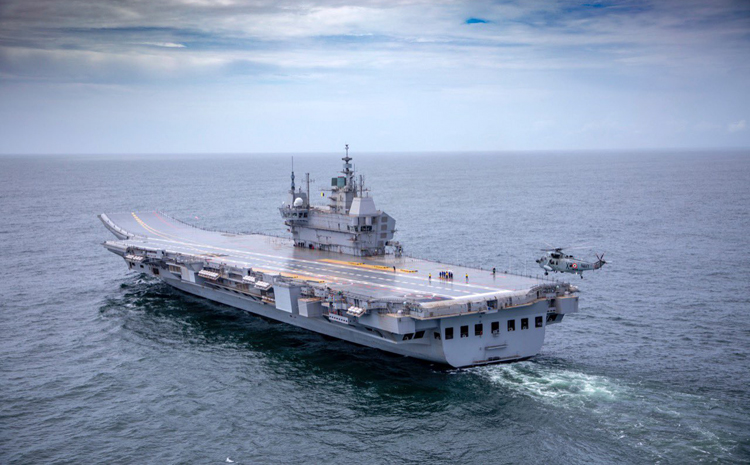
In April 2021, work began to integrate long-range surface-to-air missile (LRSAM) onboard Vikrant. On August 4, 2021, the first phase of the sea trials began which were completed successfully by August 8. The second phase of the trials was conducted on October 24, 2021, followed by the third phase from January 9 to January 17, 2022, both of which were completed successfully. On July 10, 2022, the fourth and final phase of the sea trials was successfully completed. This phase involved integrated trials of most of the equipment and systems aboard Vikrant.
With an overall indigenous content of 76 per cent, Vikrant has many indigenous equipment and machinery, involving major industrial houses in the country. Bharat Electronics Limited (BEL), Bharat Heavy Electricals Limited (BHEL), Garden Reach Shipbuilders & Engineers Limited (GRSE), Keltron, Kirloskar, Larson & Toubro, Wartsila India etc as well as over 100 Micro, Small and Medium Enterprises (MSME). The indigenisation efforts have also led to the development of ancillary industries, generating employment opportunities and bolstering plough back effect on the economy, both locally and pan-India.
With an overall indigenous content of 76 per cent, Vikrant has many indigenous equipment and machinery, involving major industrial houses in the country
Vikrant has a high degree of automation for machinery operation, ship navigation, and survivability and has been designed to accommodate an assortment of fixed-wing and rotary aircraft. The ship would be capable of operating an air wing consisting of 30 aircraft comprising MiG-29K fighter jets, Kamov-31, MH-60R multi-role helicopters, in addition to indigenously manufactured Advanced Light Helicopters (ALH) and Light Combat Aircraft (LCA) (Navy). Using a novel aircraft-operation mode known as STOBAR an acronym for Short Take-Off But Arrested Landing, the IAC is equipped with a ski-jump for launching aircraft and a set of ‘arrester wires’ for their recovery onboard.
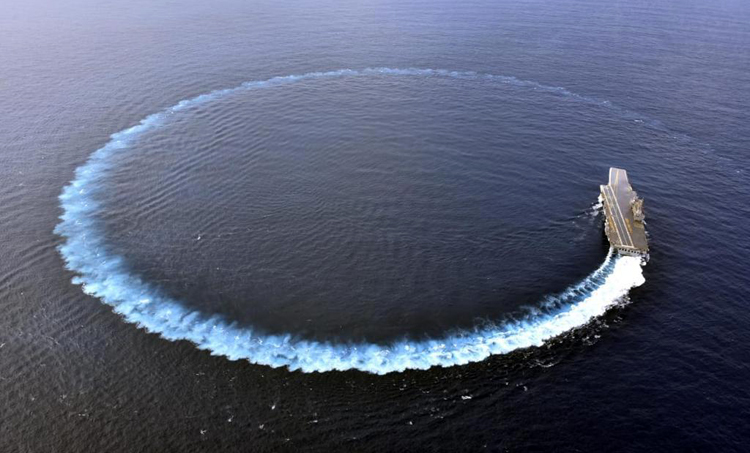
Several design iterations, including 3D Virtual Reality models and advanced engineering software, were used by the DND in shaping the carrier’s design. CSL had also upgraded their shipbuilding infrastructure and enhanced productivity skills during the ship’s building. A significant spin-off of this is the development and production of indigenous warship-grade steel for the ship through a partnership between the Navy, DRDO and Steel Authority of India (SAIL), which has enabled the country to become self-sufficient in warship steel. Today all the warships in the country are manufactured using indigenous steel.
The indigenisation efforts have also led to the development of ancillary industries, generating employment opportunities and bolstering plough back effect on the Indian economy
Vikrant was delivered to the Indian Navy by CSL following extensive user acceptance trials conducted between August 2021 and July 2022, during which ship’s performance, including hull, main propulsion, PGD, auxiliary equipment, aviation facilities, weapon and sensors, as well as sea keeping and maneuvering capabilities were proved satisfactory per trial protocols and system parameters. Delivery of Vikrant on July 28, 2022, was marked by the signing of acceptance documents on behalf of the Indian Navy by the Commanding Officer Designate of Vikrant, representatives of Naval Headquarters and Warship Overseeing Team (Kochi) and by the Chairman and Managing Director on behalf of Cochin Shipyard Ltd, in the presence of Senior officers of Indian Navy and Cochin Shipyard.
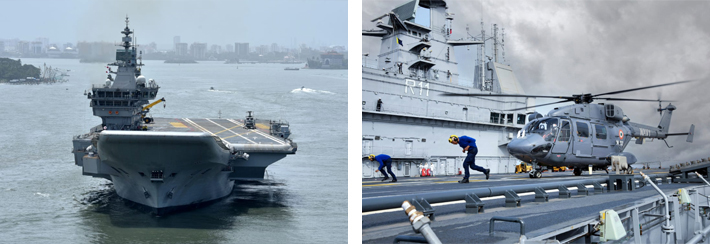
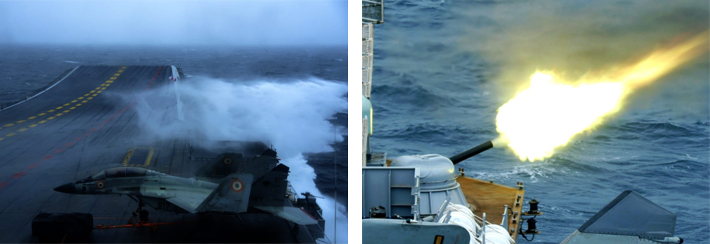
The delivery of Vikrant is the culmination of a long design, build and trials phase, during which both the Indian Navy and CSL had to overcome a multitude of unprecedented technical and logistic challenges, including the COVID-19 pandemic and changed geo-political scenario. The successful delivery of the indigenous carrier, a significant milestone activity and historical event, is testimony to the dedicated efforts of a large number of stakeholders within the Indian Navy, shipyard, industry, Original Equipment Manufacturers (OEM) and MSMEs for over two decades.
Finally, Vikrant is a boost to India’s quest of Atmanirbhar Bharat. More significantly, with Vikrant, India has joined the select group of nations with the capability to develop and design an aircraft carrier indigenously.





